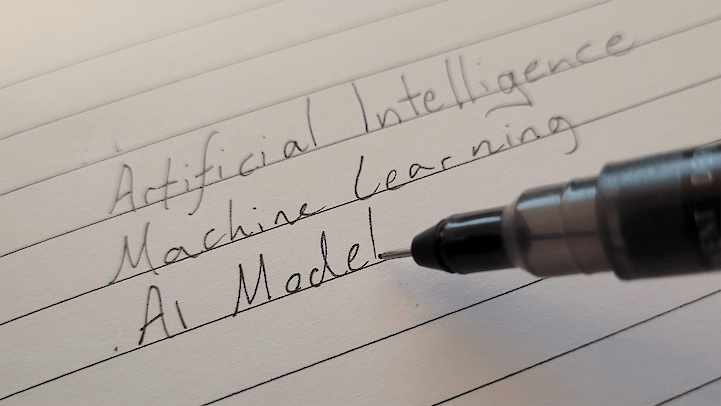From AI to NLP, the terminology necessary to understand the modern AI landscape has become overwhelming.
Here’s a simple, yet comprehensive breakdown of how we at boost.ai approach the new language of Artificial Intelligence.
Let’s face it—new AI terminology is popping up everywhere. As AI evolves, so does the need for language that accurately describes the latest innovations occurring. But here’s the catch: not every new term is truly defining something groundbreaking.

A lot of the time, it’s simply old concepts being repackaged with a fresh coat of buzzwords. It’s crucial to separate the truly novel from the recycled, so you can understand what’s really advancing the field and what’s just marketing fluff. Understanding these key terms is essential for making informed decisions about implementation, strategy, and investment, helping you navigate the AI landscape with confidence. In this guide, we'll define the language around emerging AI concepts, from the more familiar terms to some you may have never heard of, helping you navigate the AI landscape with confidence.
Artificial Intelligence (AI)
Artificial intelligence or AI, is used to classify machines that mimic human intelligence and human cognitive functions like problem-solving and learning. AI uses predictions and automation to optimize and solve complex tasks that humans have historically done, such as facial and speech recognition, decision-making, information retrieval, and translation.
Machine Learning (ML)
Machine learning involves algorithms that analyze and identify patterns within data to make predictions or decisions without being explicitly programmed. Conversational AI solutions utilize machine learning to continuously improve virtual agents, enabling them to learn from previous interactions. This increases their ability to understand and respond to user queries over time. This process relies on deep neural networks to recognize context, intent, and meaning, allowing AI to offer more accurate and personalized responses.
AI model
An AI model is a program or system trained to recognize patterns, make decisions, or generate outputs based on data. These models use algorithms and statistical techniques to learn from vast datasets, allowing them to perform tasks such as language understanding, image recognition, and predictive analysis without being explicitly programmed for each scenario. The more data an AI model is trained on, the more accurate and capable it becomes in solving complex problems.
Natural Language Processing (NLP)
Natural Language Processing (NLP) enables AI systems to understand and respond to human language. It helps machines interpret context, identify intent, and handle various forms of text or speech. Despite challenges like ambiguities and varied sentence structures, NLP enhances virtual agents, making them capable of providing more effective and human-like customer interactions.
Conversational AI (CAI)
The term Conversational AI refers broadly to systems that enable human-like interaction using AI, with conversation as the primary modality. This includes both first-generation chatbots from a decade ago, as well as the most advanced voicebots online today.
Large Language Model (LLM)
Large language models, or LLMs, are a type of AI that can mimic human intelligence. They use statistical models to analyze vast amounts of data, learning the patterns and connections between words and phrases. This allows them to generate new content, such as essays or articles, that are similar in style to a specific author or genre. LLMs are the engines that power Generative AI models.
Generative AI (GenAI):
Generative AI refers to systems that create content—text, images, videos, or music—based on input prompts. These models, such as GPT-4 or MidJourney, leverage extensive datasets to predict and produce outputs.
Chatbots
Chatbots are any AI deployment that utilizes NLP technology to understand and interpret human language. When a user interacts with a chatbot, it analyzes the input and tries to understand its intent. It does this by comparing the user's request to a set of predefined keywords and phrases that it has been programmed to recognize.
Voicebots
Voicebots are the audio equivalent of chatbots, dissecting information shared via a phone call or voice message to understand and interpret human inquiries. While often trained on the same information as chatbots, voicebots are faced with unique challenges, such as interpreting unique accents or handling inputs in multiple languages. That’s where voice IVR comes in
Voice or Conversational IVR
AI solutions use conversational IVR to transform traditional phone systems into more intuitive, human-like interactions. By understanding natural language, IVR allows customers to communicate their needs more easily and quickly, reducing wait times and improving service. This solution integrates with existing systems and continuously improves, providing a more efficient and personalized experience.
Natural Language Understanding (NLU)
NLU allows AI to comprehend and interpret the intent behind human language. It goes beyond simple text classification by using deep learning models to understand nuances, context, and word relationships in conversations. Through advanced techniques like Automatic Semantic Understanding (ASU), NLU systems can handle complex language patterns, enabling more accurate and meaningful interactions with users. This capability is crucial for creating effective virtual agents capable of addressing diverse customer needs.
AI Agents
AI Agents are autonomous or semiautonomous software entities that use AI techniques to perceive, make decisions, take actions, and achieve goals in their digital or physical environments.
Agentic AI
Agentic AI is the broader concept of solving issues with limited supervision, whereas an AI agent is a specific component within that system that is designed to handle tasks and processes with a degree of autonomy. This model is changing the way humans interact with AI. The agentic AI system is able to understand the goal or vision of the user and uses the information that is provided to solve a problem.
Guardrails
Guardrails are foundational safeguards that ensure generative AI remains accurate, on-brand, and secure. Designed to prevent undesirable or untrustworthy behavior, they allow enterprises to deploy generative models with confidence, ensuring outputs stay contextually appropriate and aligned with business requirements.
-
Local guardrails apply to specific user intents or inputs, controlling the AI’s behavior within narrow conversational contexts. These allow for precise tuning and validation, ensuring sensitive or high-risk interactions remain predictable and safe.
-
Topic guardrails restrict the AI to respond only within designated content domains, like banking or insurance, while filtering out unrelated or unsafe outputs. This ensures the AI adheres to domain-specific guidelines and maintains trust.
-
Global guardrails function system-wide, applying consistent behavior rules across all interactions. They support brand voice enforcement, compliance standards, and ethical boundaries, ensuring uniform governance throughout the AI system.
-
Hallucination guardrails are designed to prevent generative models from producing false or misleading information. By detecting and blocking unverified or non-factual outputs, they preserve the reliability of AI in critical enterprise contexts.
-
Jailbreak-Safe guardrails protect against prompt injection and jailbreak attacks by using a secure Trust Layer that filters malicious inputs and ensures the AI stays within predefined behavioral boundaries, even under adversarial pressure.
Prompt Engineering
Prompt engineering is the process of designing and refining inputs for AI models to get the most accurate and useful outputs. It involves crafting specific instructions or questions to guide the AI in generating desired responses.
Multimodal AI
Multimodular AI refers to artificial intelligence systems that can process and understand multiple types of input, such as text, voice, images, and video. By integrating these different modalities, multimodal AI can offer more accurate and comprehensive responses, making interactions more natural and effective across various communication channels.
Responsible AI
Responsible AI refers to the creation and implementation of artificial intelligence systems with an emphasis on fairness, transparency, accountability, and privacy. It ensures that AI systems operate in ways that align with ethical standards, reduce bias, and foster positive social impact. Responsible AI promotes decisions that prioritize human rights and safety, encouraging sustainable practices that benefit society and mitigate risks, especially in sensitive areas like customer data management and interactions.
Knowledge Search
Knowledge search is the next evolution of AI response generation, replacing traditional Retrieval-Augmented Generation (RAG). While RAG uses external document retrieval to supplement AI outputs, Knowledge Search accesses structured, curated knowledge bases to deliver contextually relevant, verified answers. This approach ensures higher accuracy, reduces hallucinations, and provides real-time, enterprise-ready responses that align with business knowledge and intent. By grounding generative AI in trusted data, Knowledge Search supports more scalable and controllable virtual agent experiences.
Orchestration Layers
Orchestration layers in AI systems is responsible for managing and coordinating various AI components, tools, and workflows to ensure they work together efficiently. It serves as the central hub that directs tasks, handles data flows, and ensures smooth interaction between different parts of the system, allowing AI to function effectively across different platforms and environments.
Hybrid AI
Hybrid AI blends predefined responses with generative AI to create more accurate and flexible virtual agent interactions. This combination allows AI systems to use structured, rule-based responses for known queries, while also generating dynamic, context-aware responses when needed. The result is an enhanced user experience, with faster, more reliable answers alongside the ability to handle complex, unique situations.
Algorithm
An algorithm is a procedure used for solving a problem or performing a computation. Algorithms act as an exact list of instructions that conduct specified actions step by step in either hardware- or software-based routines.
AI Testing
AI Testing involves evaluating and validating AI models throughout their lifecycle, both before and after deployment. Initially, it ensures that AI systems perform as expected, handling diverse inputs and meeting business goals. Post-deployment testing focuses on continuous monitoring, identifying issues, and optimizing performance. Tools like AI-powered CX Insights help in gathering valuable user interactions and refining AI responses over time. This ongoing testing process ensures that AI solutions remain reliable, effective, and aligned with user needs.
As AI continues to reshape industries, understanding the right solutions for your business is essential to staying ahead of the curve and delivering top-notch customer experiences. Whether you’re just beginning to explore AI or looking to enhance your existing systems, navigating this evolving landscape requires the right tools and insights. At boost.ai, we specialize in helping businesses like yours harness the power of conversational AI to transform customer interactions. Our team is here to guide you in selecting and implementing AI solutions that meet your unique needs, ensuring you stay innovative, efficient, and customer-focused.
Connect with us today to discover how we can support your journey with AI!



